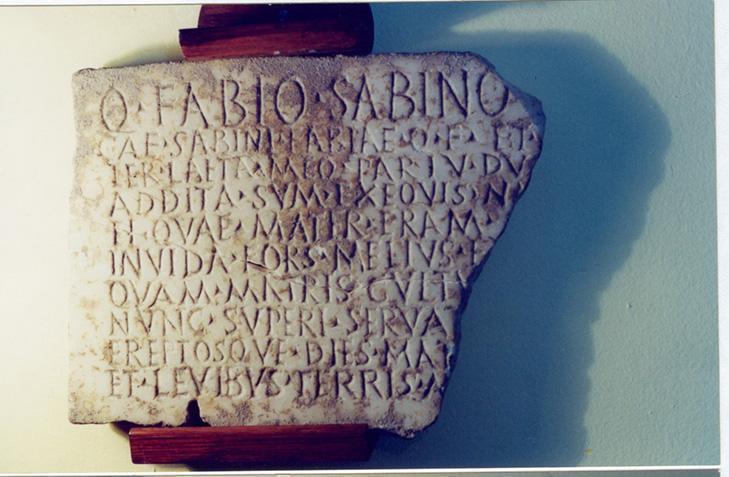Epitaph on the family tomb of Quintus Fabius Sabinus
Reference HEp 1997, 867 | Description | Lyrics | Location | Chronology | Epigraphic edition | Translation | Apparatus | Comentary | Type of verse | Text divided into verses and metric signs | Images | Bibliography | Link to DB | Author |
Epitaph on the family tomb of Quintus Fabius Sabinus
Description
- Idno filename 22/01/0023
- Type of inscription: Sepulcralis
- Support: Tablet
- Material: Marble Material Description: White marble. From Macael.
- Conservation status: Two adjoining fragments: the right half is missing. Measuring: 25 x (32) x 2.7 (right side) and 3.2 (left side).
- Dimensions height/width/depth (cm): 25/32/2.7
-
Epigraphic field:
- Layout: Triangular interpunctions. Relatively good layout, although two words are split: l. 2 -cae and l. 3 –ter. The first line mentions the founder of the tomb in larger letters, followed by the names of the other beneficiaries
- Epigraphic field execution: Polished epigraphical field.
- Preserved
Lyrics
- Font:Capital cuadrada
- Letter size:3-2 cm
- Description of the letters:Letters decreasing in height, 3-2. Deep cut. In l. 3 the second <A> of laeta has a horizontal stroke, an attempt at correction by the cutter. The <T> gives rise to confusion: it is sometimes missing the upper stroke (l. 3 partu) and at other times the stroke is very small (l. 3 ter); at the beginning of l. 5 it is difficult to decide between ei / et-, while in other cases the letter is normal.
Location
- Place of discovery: Found in the grounds of the former orujo factory owned by Sr. Vidiella, to the north of the castle of Lora. It was discovered at least 70 years ago, but we have no further information.
- Geolocation
- Conservation location: Conserved in a private collection in Lora del Río.
- Location with Modern Nomenclature España / Sevilla / Lora del Río
- Location with Old Nomenclature Hispania / Baetica / Hispalensis / Axati
Chronology
- Inscription's dating: Between year 150 and year 199
- Dating explanation: The early editors dated it to the 1st c. AD. CANTO considers it later, second half of the 2nd c. DI STEFANO (per litteras) dates it to between the end of the 1st c. BC and the beginning of the 1st c. AD from the type of interpunction (triangles sitting on their base) and the absence of a cognomen for the daughter.
Type of verse
- Type of verse: Dactílico (hexámetro)
- Verse/line correspondence: Si
- Prose/verse distinction: Si
Epigraphic edition
Q(uinto) ▴ Fabio ▴ Sabino [Rusti-]
cae ▴ Sabini ▴ Fabiae ▴ Q(uinti) ▴ f(iliae) ▴ et ▴ [‑ ‑ ‑]
ṭer ▴ laeta’t’a ▴ meo ▴ par˹t˺u ▴ du[m vita manebat]
addita ▴ sum ▴ exequi<i>s ▴ nạ[torum?—]
5 e˹t˺▴ quae ▴ mater ▴ eram ▴ [‑ ‑ ‑]
invida ▴ fors ▴ melius ▴ e+[‑ ‑ ‑]
quam ▴ matris ▴ cultu [‑ ‑ ‑]
nunc ▴ superi ▴ servaṭ[e] [‑ ‑ ‑]
ereptosque ▴ dies ▴ mat[ri‑ ‑ ‑]
10 et ▴ levibus ▴ terris ▴ ṃ[‑erito ? ‑ ‑]
Text divided into verses and metric signs
Ter laetata meo partu du[m vita manebat] ll|lkk|l/l|l/l|[lkk|l~]
addita sum exequiis na[torum? – – -] lkk|lkk|l/l|[lx|lkk|l~]
ei quae mater eram [- – -] ll|lkk|x[n|ln|lkk|l~]
invida fors melius e[- – -] lkk|l/kk|k/x|[ln|lkk|l~]
5 quam matris cultu [- – -] ll|l/l|x[n|ln|lkk|l~]
nunc, superi, servat[e – – -] lkk|l/l|l[x|ln|lkk|l~]
ereptosque dies mat[ri – – -] ll|lkk|l/l|[xn|lkk|l~]
et levibus terris m[erito? – – -] lkk|l/l|l/[kk|xn|lkk|l~]
Translation
“To Quintus Fabius Sabinus, to... (Rusti)ca, wife of Sabinus, to Fabia , daughter of Quintus and to.... Three times blessed as a mother, [while I lived], I have been joined the funeral rites [of my child(ren)]... and I, who was their mother,... Cruel Fortune,... [it would have been] better... that, thanks to the care of their mother... Now, you who are alive, take care of (this tomb?)... and the lives snatched [from a mother]... and with light soil...”
Bibliography
Remesal – Gómez Pallarès 1996, 53–66; (inde Rodríguez Almeida 1998, 129–133 [AE 1998, 736]; HEp 1997, 867); Fernández Martínez – Carande 2007, 241–246; Fernández Martínez – Carande, CLEB, SE7, cum im. phot, quae in linguam Hispanicam verterunt; Cugusi 2012, 5. – Cf. Hernández Pérez 2001a, 2, 7–8, 35, 44, 242, 294; Cugusi 2007, 61-62.
Apparatus
1 Sabino [Rusti]cae RODRÍGUEZ ALMEIDA 3 laeta REMESAL – GÓMEZ PALLARÈS, laetata correxit RODRÍGUEZ ALMEIDA. – 6 melius e[is] REMESAL – GÓMEZ PALLARÈS. – 8 servat[e] supplevimus.
Comentary
Rodríguez Almeida believed that this was in elegiac distichs and proposed erroneous reconstructions (without parallels and without respecting prosody and metrics) (cf. Fernández Martínez – Carande, CLEB, SE7); even so, Canto in HEp 7 agreed with the reconstructions.
There are problems in interpretation, both in the metrics and in the number of dedicatees and their kinship, as well as in the identity of the dedicant. It could be a family tomb with four deceased: Quintus Fabius Sabinus and his wife (mater), [Rusti]cae. In addition, we read the gamonym Sabini and the name of the third deceased, the daughter of both with no cognomen: Fabiae.
L.2 the conjunction et is conserved, and would have been followed by the name of a second child. The couple must have had (according to ter) a third child, the sole survivor, who could be the dedicant. L. 3, the final A of laeta makes the function of two letters thanks to the upper stroke that turns the A in TA, already appreciated by Rodríguez Almeida; a good parallel for this correction resource can be found in a signaculum (CIL XV 8568). There it appears a rationibus with <AR> united in a ligature, so that it can be used for the preposition (first use) and for the a of rationibus (second use); l. 3, possible restitutions from the hepthemimeres: dum vita manebat/maneret (abundant literary parallels with the sequence in the same position: Verg. Aen. 5,724; 6,608; 6,661; Stat. Theb. 6,166; also epigraphic: cf. 514,1; 1347A,17; etc.). The form partu in singular is acceptable in spite of being accompanied by the numeral ter (cf. CLE 1389,11-12: natorum splendore potens… gaudebat partu se reparasse patres). L. 4: if we reconstruct another –i- in exequiis, which was perhaps omitted inadvertently – its contraction in fact does not contribute to the scansion of the verse, we obtain either the three first feet of the hexameter with penthemimer caesura, or a first hemistich of pentameter and the beginning of the second. The funeral remains are designated here with the form exequi(i)s (cf. exequiae en ThLL II.2: i.q. corpus mortuum, cadaver). There are enough epigraphic parallels in which exequiae has such meaning; therefore, for example, in CLE 1297,6: exequias geminas nunc cinis unus habet; or in 1969,17: exequias ibi sollemni de more frecuentant. This would confirm our hypothesis of a collective family burial with an epitaph perhaps written by the third son (living dedicant) in honor of his parents and siblings. In short, the verse would be similar to Ov. Met. 8.505: me fraternis adde sepulcris and Ib. 581: addidit ut fidicen miseris sua funera natis. L. 5: ei for et: when referring to the carmen of several deceased, is more appropriate (cf. PARIV por PARTV). In l. 9 we suggest mat[ri] when evoking expressions such as CLE 1066,4: ereptum sibi quem luget uterque parens; or CLE 1867,5: seque ipse[i deflent, vit]am esse ereptam sibei. In l. 10, the letter M from the right margin might belong to the word merito (cf. CLE 477.3 est mihi terra levis merito).
A series of hexameters, as deduced from the scansion. L. 4: three first feet of a hexameter with penthemimers, or of a pentameter to the iunctura. This last possibility seems unlikely, since after exequi(i)s one would expect nati/natorum (the N is complete and the A is the only possible reading given the remains of the letter that are preserved), words whose prosodic sequence is incompatible with the second hemistich of a pentameter. L. 6, problem of prosody: the last short syllable of melius, is in a stressed position. If it were a pentameter, we would have to consider it a brevis in longo preceding a iunctura, a phenomenon which Luque 1994, 46, considers algo completamente excepcional y, aun así, no siempre seguro (absolutely exceptional but, even so, not always certain); the presence of a brevis in longo in a hexameter would not be such a problem: there are examples from Virgil, cf. Aen. 4,64. L. 8 could include an appeal to the relatives or living friends (superi) servat(e); thus it is impossible for this verse to be a pentameter; for servate, also in l.8, cf. Verg. Aen. 2.202: di patrii; servate domum, servate nepotem and 3.266: et placidi servate pios. The proposal by Hernández Pérez 2001a, 242, to reconstruct a second hemistich such as molliter ossa cubent (Ov. Am. 1,8,108) for l. 10 would not be suitable.
Author
- Author:C. Fernández Martínez, R. Carande Herrero
- Last Update2024-03-04 07:59:48
- Autopsy date:2001
You can download this






